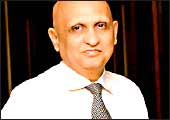 |
| HDFC Bank's Aditya Puri:
Focussing on high margins in each of the business
segments |
In the solemn world of commercial
banking, where suits and ties, convention and conforming to a fault
are the norm, it's difficult to tell one banker from another. Aditya
Tapishwar Puri and Kundapur Vaman Kamath are two refreshing examples
of bankers who don't quite fit the mould-and who are as different
from each other as black and white. The 56-year-old Puri, for instance,
is unlikely to be spotted at an evening cocktail do (unless of course
it's the BT Best Banks Award ceremony), preferring instead to head
home for an evening walk along the Worli Sea Face in Central Mumbai.
Fifty-nine-year-old Kamath, for his part, is a habitual networker,
and is often heard in public forums articulating his vision for
ICICI Bank or his views on the state of the economy. A career banker,
Puri is a chartered accountant by qualification; Kamath is a product
of IIM Ahmedabad. Prior to that, Puri earned a bachelor of commerce
degree from Punjab University; Kamath did mechanical engineering
from Karanataka University. Puri left his cushy Citibank CEO post
in Malaysia to start HDFC Bank from scratch in 1994; Kamath, who
started his career with ICICI Ltd (then a development financial
institution) did an eight-year stint with the Asian Development
Bank in Manila after which he returned to head ICICI Ltd in 1996.
He went on to head ICICI Bank when ICICI Ltd was merged into it
five years ago.
 |
| ICICI Bank's K.V. Kamath:
Betting big on volumes and market share |
When you have such distinctive personalities leading the charge at
two of the country's most respected and fastest growing banks, it's
perhaps unsurprising that the banks in question-HDFC Bank and ICICI
Bank-are following very different strategies for growth. To be sure,
growth is the single-minded objective for both, but the game plan
to achieve that growth couldn't be more different. For instance,
right from start, HDFC Bank's focus has been margin-led growth.
ICICI Bank on the other hand is obsessed with volumes and market
share. In the 13th BT-KPMG study on India's best banks, HDFC Bank
takes pole position, thanks largely to consistency of performance
over the past few years. ICICI Bank has emerged as the fastest-growing
bank in the survey. As far as scores go, HDFC Bank tallied 2,487.50,
edging out ICICI Bank which follows close behind with 2,453. Whilst
both banks ran neck-and-neck on parameters like operating profit
growth and fee income to total income, what tilted the scales in
HDFC Bank's favour was the quality of earnings ranking, where it
comes in fourth, as against ICICI Bank's 33rd position.
| THE ARMOUR AND
THE CHINKS |
| Strengths and weaknesses of the two
banks. |
ICICI BANK
STRENGTHS
Strong balance sheet
Expanding international and rural business
Well-established subsidiaries in life and non-life insurance
and AMC business
Strong bench-strength |
| WEAKNESSES |
Frequent capital dilution
Lesser share in low-cost deposits, still to fix liability
mix
Large retail portfolio may breed NPAs going forward
No promoters, shareholding quite scattered
HDFC BANK |
| STRENGTHS |
Large share of low-cost deposits, higher net
interest margin
Better quality of assets, NPA of 0.4 per cent
Free float available, FIIs can buy its stock
Higher profitability |
| WEAKNESSES |
Marginal international presence
No next line of leadership
Not very aggressive in M&A space, growing only organically
Possible takeover target |
While HDFC Bank maintained its best bank status for the fourth
year in a row, ICICI Bank has pole-vaulted from 13th position
in the 2005 ranking to the runners-up slot in 2006. A section
of market analysts feels it's unfair to stack up the two banks
against each other, as ICICI is more than three times HDFC's size,
which makes it difficult to compare their growth rates. HDFC Bank
has a balance sheet size of Rs 89,700 crore in March 2005-06,
while ICICI Bank has a balance sheet size of Rs 2,82,400 crore.
The former has a market capitalisation of $7.1 billion (Rs 31,950
crore) while the latter has a market cap of $19.8 billion (Rs
89,100 crore).
 |
"We want to explore
opportunities in overseas markets to fund India Inc's acquisitions
abroad"
Harish Engineer/Country Head (Wholesale Banking), HDFC Bank
|
Put such numbers in front of Puri, and the Managing Director
of HDFC Bank will most likely tell you: "It is the relevant
size that matters, and not just size." What Puri means is
that his bank is amongst the leaders-either #1 or #2 in many segments,
be it car loans, credit cards or personal loans. "We will
not sacrifice margins for market share, but neither will we be
in a business if we are not amongst the top three players,"
adds the MD.
For his counterpart at ICICI Bank, size is almost an obsession.
"For a country growing at 8-10 per cent, creating financial
intermediaries of size becomes an absolute critical requirement,"
Kamath had told BT recently. Puri agrees that "a country
like India requires at least some banks with scale." But
he's quick to add that "managing a domestic business and
an international business is very different."
Whilst Puri's vision is to make HDFC a world-class Indian bank,
ICICI Bank has been aggressively chasing international growth.
Today, 18 per cent of its business comes from foreign shores,
and the target is to take it to 25 per cent by 2010. It's not
as if Puri has ruled out overseas forays, what with huge potential
waiting to be tapped on the cross-border lending and as well as
advisory fronts. Harish Engineer, Country Head (Wholesale Banking)
at HDFC Bank, says: "We have recently set up a capital market
group to explore opportunities in the international market especially
in areas like resource mobilisation for Indian corporate sector."
"We want to set up a focussed international business,"
adds Puri, who is now eyeing rep offices or branches in countries
like the US, Canada, South Africa, Singapore, Hong Kong, Bahrain
and Indonesia. "We are also studying the subsidiary model
in countries like the UK."
 |
"We have become larger
than any other Indian bank present in the UK and Singapore"
Chanda Kochhar/Deputy MD (International), ICICI Bank |
Puri might just be taking a good look at ICICI Bank's UK subsidiary,
which runs the largest foreign banking operation with a focus on
non-resident Indian remittances and internet banking services for
local UK customers. "In just two and a half years, in some
geographies like the UK and Singapore, we have become much larger
than any other Indian Bank, which were present in those geographies
for decades," says Chanda Kochhar, Deputy Managing Director
at ICICI Bank. ICICI Bank is already reaping the fruits of successful
international operations with the bank mobilising $2 billion (Rs
9,000 crore) through a bond offering; these funds will be deployed
for India Inc's march in overseas markets. Engineer adds that HDFC
Bank too is extremely keen to borrow overseas, and thereby also
play a role in funding India Inc's overseas acquisitions and capacity
expansions.
Whilst ICICI Bank may be a step ahead on the overseas front,
the two are running in tandem back home with their strategies,
not just in the cities but in semi-urban and rural India too.
HDFC's game plan is two-pronged: To offer a better customer experience
in the densely banked areas even as it explores new territories.
For the next phase of its growth, HDFC Bank is working with Cisco
in a bid to provide the next-generation customer experience. The
bank has been working on this project for the last two years and
most of these new measures would come into play in 90 to 120 days.
"We are integrating technology, product offering and front-end
customer contact to address customer needs," says Pralay
Mondal, Country Head (Credit Card & Two-wheeler) at HDFC Bank.
Puri is quick to remind you that future growth at HDFC Bank-like
its current growth won't be at the cost of margins. "That
will allow us to take care of any shocks," he says.
 |
"We have been changing
the mix of the liability. Our asset mix is also undergoing
change"
V. Vaidyanathan/Executive Director (Retail), ICICI Bank |
It appears ICICI Bank doesn't have any such qualms, as it goes
about aggressively chasing retail growth with the 300-million
strong middle class as its target customer base. Yet, one way
the bank is spreading its risks is by moving away from the big
cities, into smaller towns and villages with a low-cost franchisee
model (as against putting up higher-cost branches). Also fuelling
the rural thrust will be acquisitions, like the recent one of
the old private sector Sangli Bank, which has close to 200 branches
in Maharashtra, most of them on the rural sugar belt.
In the meanwhile, HDFC Bank has lined up products for the rural
masses. "We are witnessing exponential growth in mini-metros
and beyond as well as in products like two-wheelers, auto and
tractor loans, kisan card, gold loans and educational loans,"
says Mondal. But acquisitions may not be its cup of tea. In the
past, HDFC Bank did take a close look at Centurion Bank, Lord
Krishna Bank and Global Trust Bank (which have since been acquired
by Rana Talwa's Sabre Capital, Centurion Bank of Punjab and Oriental
Bank of Commerce, respectively). "Any acquisition must increase
our market share, or add to our geographical coverage or reduce
cost and add to scale," says Puri. HDFC Bank made its last
acquisition, of Times Bank, in 1999-2000.
 |
"We are integrating
technology and product offering to address customer needs"
Pralay Mondal/Country Head (Credit Card & Two-wheeler),
HDFC Bank |
If ICICI Bank trails HDFC Bank on the quality of earnings and
quality of assets fronts, it may be because it still has to get
its liability mix right, thanks to the legacy it inherited from
ICICI before it was merged into bank. Even today, a substantial
portion of its liability continues to be corporate deposits, whereas
for the banking system it is quite the reverse. HDFC has no such
issues and in fact has the highest share of casa (current account
and saving account) in the Indian banking system, at 55 per cent.
ICICI Bank's casa share is in the 20-25 per cent region. "ICICI
Bank is still a bank in transformation. We are not done yet,"
points out V. Vaidyanathan, who heads the largest retail portfolio
in the country. "We have been changing the mix of the liability
over the years. Our asset mix is also undergoing change,"
adds Vaidyanathan.
On Dalal Street, both stocks are perennial investor favourites,
although HDFC Bank enjoys a superior price-earnings ratio (P-E),
of 21 on 2007-08 earnings as against a P-E of 18 for ICICI Bank.
"It's purely the fundamentals that give HDFC Bank a better
p-e than ICICI Bank," explains Kashyap Jhaveri, Banking Analyst
at Emkay Share and Stock Brokers. There are those analysts who
argue that it is HDFC Bank's vulnerability as a takeover target
that gives it a better P-E, a theory that Puri is quick to dismiss.
"We have got a better margin, a lower default rate, and less
risky strategy," he quips. Adds Manish Karwa, Banking Analyst
at Motilal Oswal Securities: "HDFC Bank's return on equity
is better; also foreign institutional investors can buy stock
as free float is easily available."
Banking experts say both banks needs a robust management in
a market where talent is difficult to hold on to. Recently HDFC
Bank lost two key people, Neeraj Swaroop to Standard Chartered
Bank and Samir Bhatia to Barclays Bank. ICICI Bank has been able
to build around its core team of Deputy Managing Directors Nachiket
Mor and Chanda Kochhar, and Executive Director Vaidyanathan and
Shikha Sharma, MD of the insurance subsidiary. "The bench-strength
results in better strategy formulation and execution for the bank,"
believes Vaidyanathan. Clearly both banks have their areas of
strength, which are enabling them to chase long-term growth. And
there's ample room for both to grow in a booming economy in their
own inimitable ways.
|










